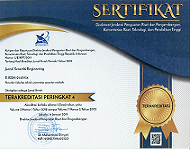Marketing Strategy Determination Using Markov Chain and Game Theory: A Case Study of Ready-to-Drink Tea Products
Keywords:
Packaged Tea Drinks, Markov Chain, Game TheoryAbstract
Decrease in the number of demand in the market and the transfer of consumers from the Nuu Green Tea brand to the Pucuk Harum Tea brand or vice versa is a result that can occur from market share competition. The calculation results obtained after doing manual calculations using the Markov chain method are the probability of transferring the subscription from each product a few times ago, at this time, and the time to come. For the time to come alone based on the steady state obtained is in the 10th year period. With the probability value of the movement from the shoot tea to Nuu Green Tea is 0.413 for a period some time ago and at this time, for other products transfer can be seen in Figure IV.6. For the value of the steady state in the 10th iteration with the mastery of the shoots of the market share of 0.4158 or 41.58% and Nuu Green Tea controlled the market share of 0.5841 or 58.41%. The calculation results that have been done manually and the use of application assistance can be concluded that the use of the maximin-minimax method produces an optimum solution, namely on X1 for row players (The Pucuk), and Y1 for column players (Nuu Green Tea). With a game value of 32. then the best marketing strategy used by Teh pucuk and Nuu Green Tea is the attribute 'flavor variant' by utilizing the flavor variant of the two can compete in the flavor variant.
References
[1] M. L. EsquÃvel and N. P. Krasii, "Statistics for Continuous Time Markov Chains, a Short Review," Axioms, vol. 14, no. 4, p. 283, 2025. [Online]. Available: https://www.mdpi.com/2075-1680/14/4/283.
[2] V. Lukitosari, T. Simanjuntak, and D. Utomo, "A game-theoretic model of marketing strategy using consumer segmentation," Journal of Physics: Conference Series, vol. 1490, p. 012026, 03/01 2020, doi: 10.1088/1742-6596/1490/1/012026.
[3] A. Tenadi and E. Ervina, "The preference mapping and the drivers of liking for ready-to-drink tea beverages," IOP Conference Series: Earth and Environmental Science, vol. 1413, p. 012062, 11/01 2024, doi: 10.1088/1755-1315/1413/1/012062.
[4] D. Dinh, Q. Nguyen Minh, and B. Chi, "A Markov Chain Model for Predicting Brand Switching Behavior Toward Online Food Delivery Services," 2022, pp. 781-797.
[5] R. K. Gupta, D. Khan, and S. Banerjee, "Markovian Brand Switching Model for Long-Term Steady-State Market Shares: A Study on Toothpaste Market," in Decision Making Under Uncertainty Via Optimization, Modelling, and Analysis, L. Sahoo, T. Senapati, M. Pal, and R. R. Yager Eds. Singapore: Springer Nature Singapore, 2025, pp. 567-581.
[6] P. R. Brahma and K. N. Revi, "Dynamic Modeling of Brand Loyalty in Retail: A Semi-Supervised Approach Incorporating Temporal Effects and Purchase Behavior Sequences," in 2024 IEEE 9th International Conference for Convergence in Technology (I2CT), 5-7 April 2024 2024, pp. 1-7, doi: 10.1109/I2CT61223.2024.10543726.
[7] C. Kotaru, P. Udayaraju, D. Kolasani, R. Sayana, S. Tumkunta, and V. Gummadi, "Behavioral Pattern Analysis Framework with Markov Chains and Graph Neural Networks for Scalable Customer Behavior Prediction in Travel Reservations," in 2025 International Conference on Machine Learning and Autonomous Systems (ICMLAS), 10-12 March 2025 2025, pp. 880-888, doi: 10.1109/ICMLAS64557.2025.10968512.
[8] M. Mahdi and M. Jabbari, "Predicting customer churn in the fast-Moving consumer goods segment of the retail industry using deep learning," Mathematics and Computational Sciences, vol. 5, no. 3, pp. 58-79, 2024, doi: 10.30511/mcs.2024.2032592.1189.
[9] N. Z. Rizkita, S. Sutanto, and N. A. Kurdhi, "GAME THEORY AND MARKOV CHAIN ANALYSIS OF THE DISPLACEMENT OF SHOPPING MALL VISITORS IN SURAKARTA CITY," BAREKENG: Jurnal Ilmu Matematika dan Terapan, vol. 19, no. 2, pp. 1047-1056, 2025.
[10] L. Amalia, F. Hayatuki, S. Muliani, and A. M. Junaidi, "Advantages and Disadvantages of Utilizing Markov Chains in a Digital Marketing Strategy to Predict E-Commerce Sales," Scientia. Technology, Science and Society, vol. 1, no. 3, pp. 43-61, 2024, doi: 10.59324/stss.2024.1(3).03.
[11] s. RouhaniRad, M. R. Akhavan Anvari, and K. Raissifar, "An Integrated Ranking Model of Tehran Stock Exchange Companies Using Bayesian Best-Worst, CoCoSo, and MARCOS Methods (Case Study: Food and Beverage Companies)," International Journal of Finance & Managerial Accounting, vol. 10, no. 39, pp. 55-88, 2025, doi: 10.30495/ijfma.2023.68893.1895.
[12] L. Cheng, M. Zhang, P. Huang, and W. Lu, "Game-Theoretic Approaches for Power-Generation Companies’ Decision-Making in the Emerging Green Certificate Market," Sustainability, vol. 17, no. 1, p. 71, 2025. [Online]. Available: https://www.mdpi.com/2071-1050/17/1/71.
[13] A. R. Habibi, M. T. Sembiring, and A. Anizar, "Model for Determining the Optimum Marketing Strategy for Schneider Electric Products Using Game Theory Approach (Case Study: Authorized Distributor Schneider Electric)," Jurnal Sistem Teknik Industri, vol. 27, no. 2, pp. 76-91, 2025, doi: 10.32734/jsti.v27i2.18363.
[14] A. Igboanugo and O. Edokpia, "A Markovian Study of Manpower planning in the soft-drink industry in Nigeria," Nigerian Journal of Technology, vol. 33, no. 4, pp. 547-552, 2014, doi: 10.4314/njt.v33i4.15.
[15] F. Mourdoukoutas, B. T. J., P. A. A., and G. and Taylor, "Competitive insurance pricing strategies for multiple lines of business: a game-theoretic approach," Scandinavian Actuarial Journal, pp. 1-27, doi: 10.1080/03461238.2025.2460159.
[16] O. Dogan, A. Hiziroglu, A. Pisirgen, and O. F. Seymen, "Business Analytics in Customer Lifetime Value: An Overview Analysis," WIREs Data Mining and Knowledge Discovery, vol. 15, no. 1, p. e1571, 2025, doi: https://doi.org/10.1002/widm.1571.
[17] Z. Q. Zhou and A.-S. Shia, "A Study on the new Media Marketing Strategies of new Tea Beverage Companies: A Case Study of KF Cha," Asian Business Research Journal, vol. 9, pp. 45-55, 2024, doi: 10.55220/25766759.184.
[18] A. r. T. Rosário and R. Raimundo, "Importance of Competitive Dynamics of Strategic Groups: Opportunities and Challenges," Administrative Sciences, vol. 14, no. 7, p. 147, 2024. [Online]. Available: https://www.mdpi.com/2076-3387/14/7/147.
[19] Y. Chen and B. Hong, "Tea industry's sustainable development: based on participants' tripartite evolutionary game and numerical simulation," International Journal of Simulation and Process Modelling, vol. 18, no. 1, pp. 61-76, 2022/01/01 2022, doi: 10.1504/IJSPM.2022.123475.
[20] M. Abedian, A. Amindoust, R. Maddahi, and J. Jouzdani, "A game theory approach to selecting marketing-mix strategies," Journal of Advances in Management Research, vol. 19, pp. 139-158, 05/03 2021, doi: 10.1108/JAMR-10-2020-0264.
[21] W. Febriansyah, R. M. Yunita, and R. Nugraha, "Effect of Social Media Marketing “Instagram†Towards Purchase Intention: Evidence From Plant-Based Milk Product “Oatside†in Indonesia," Eduvest-Journal of Universal Studies, vol. 4, no. 2, pp. 670-686, 2024, doi: 10.5267/j.ijdns.2020.3.002.
[22] S. Zhao, "Analysis on the Marketing Strategy of New Tea Drinks in China: A Case Study of HEYTEA," Advances in Economics, Management and Political Sciences, vol. 5, pp. 259-265, 04/27 2023, doi: 10.54254/2754-1169/5/20220088.
[23] X. Kong, J.-P. H. Dubé, and Ã. y. Daljord, "Nonparametric Estimation of Demand with Switching Costs: the Case of Habitual Brand Loyalty," National Bureau of Economic Research, 2024. DOI: 10.3386/w32994
Downloads
Published
Issue
Section
License
Copyright (c) 2025 Mochamad Rafi Herdiana (Author); Yulida Intani Dewi (Translator); Zulfa Fitri Ikatrinasari, Uly Amrina (Author)

This work is licensed under a Creative Commons Attribution 4.0 International License.












